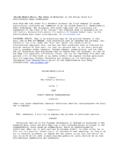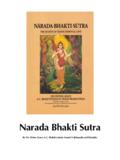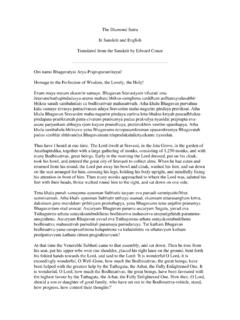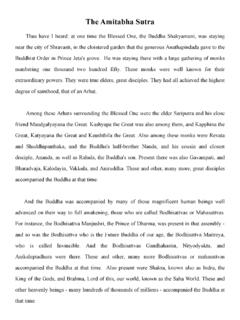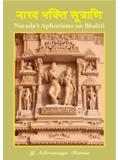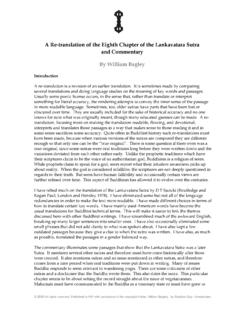Transcription of Wisdom of Buddha - Stiltij
1 Wisdom of BuddhaThe Samdhinirmocana SutraTranslated byJohn PowersDharmaPublishingTIBETAN TRANSLATION SERIES1. Calm and Clear2. The Legend of the Great Stupa3. Mind in Buddhist Psychology4. Golden Zephyr (N g rjuna)5. Kindly Bent to Ease Us, Parts 1-36. Elegant Sayings (N g rjuna, Sakya Pandita)7. The Life and Liberation ofPadmasambhava8. Buddha 's Lions: Lives of the 84 Siddhas9. The Voice of the Buddha (Lalitavistara S tra)10. The Marvelous Companion (J takam l )11. Mother of Knowledge: Enlightenment ofYeshe Tshogyal12. The Dhammapada (Teachings on 26 Topics)13. The Fortunate Aeon (Bhadrakalpika S tra)14.
2 Master of Wisdom (N g rjuna)15. Joy for the World (Candrak rti)16. Wisdom of Buddha (Samdhinirmocana S tra)Library of Congress Cataloging-in-Publication DataTripkaka. Samdhini^mocanas t^a. EnglishWisdom of Buddha : the Samdhinirmocana S tra / translated byJohn cm. - (Tibetan translation series.)Includes bibliographical references and 0-89800-247-8. - ISBN 0-89800-246-X (pbk.)I. Title. II. '85-dc20 94-25023 CIPC opyright 1995 by Dharma Publishing. All rights part of this book, including text, art, reproductions, and illustrations,may be copied, reproduced, published, or stored electronically, photo-graphically, or optically in any form without the express written consent ofDharma Publishing, 2425 Hillside Avenue, Berkeley, CA 94704 USAF rontispiece: Courtesy of the Metropolitan Museum of ArtGift of Joseph H.
3 Heil, 1970 ( )This publication was sponsored by a generous donation from Michael in the United States of America by Dharma PressTypeset in ITC Zapf Book Light with WP Murray Hill initials987654321 May this meritorious actionliberate all sentient beings from sams raand establish them on the Bodhisattva pathContentsPreface xiiiIntroduction xvThe Setting and Chapter One:The Chapter of Gambh r rthasamdhinirmocana 3 Chapter Two: The Questions of Dharmodgata 23 Chapter Three: The Questions of Suvi uddhamati 3 3 Chapter Four: The Questions of Subh ti 51 Chapter Five: The Questions of Vi lamati 67 Chapter Six: The Questions of Gun kara 79 Chapter Seven: The Questions of Param rthasamudgata 93 Chapter Eight: The Questions of Maitreya 147 Chapter Nine.
4 The Questions of Avalokite vara 219 Chapter Ten: The Questions of Ma ju r 273 Notes 313 Abbreviations 371 Bibliography 373 Glossary 384 Index 386
5 Preface/^TNuddhism teaches that life is precious. If we wish to useO our limited time on earth to create a truly meaningfulexistence, there is no better foundation than the Dharma, theteachings of the Buddha taught for almost fifty years, and althoughmany of his teachings have been lost over the millennia, thou-sands of texts have been preserved in Sanskrit, Pali, Tibetan,and Chinese, bringing the Wisdom of the Dharma to manylands. Only a few hundred of these texts have been translatedinto Western languages. Each new translation reveals furtheraspects of the Buddha 's realization, confirming the value ofthe Dharma and the depth and richness of the this publication, the Samdhinirmocana S tra be-comes available in its entirety in English for the first a S tra of definitive meaning, the Samdhinirmo-cana is among the extraordinary teachings that the Buddhagave to the advanced Bodhisattvas.
6 Its brilliance illuminatesideas and practices of great depth and in scope, the Samdhinirmocana is rich in profoundmeaning that cannot be fully fathomed in one reading. How-ever, patient study, reflection, and rereading will evoke clearinsight into the Buddha 's awakened the deep and subtle meanings of a text such asthe Samdhinirmocana into clear, readable English is a de-manding task. Buddhist terminology and perspectives are stillunfamiliar to the West, and the vocabulary available cannotalways convey the ideas being expressed. In the eighth andninth centuries, when the Dharma was being transmitted toTibet, Indian parkas and Tibetan lots was worked togetherto establish uniform standards of translation.
7 As similarefforts are carried out in the West, the challenge of communi-cating the heart of the Dharma teachings will become easierand the results more accurate. I hope that the present transla-tion will inspire efforts in this over twenty years Dharma Publishing has been dedi-cated to producing Buddhist books and art of the highestquality. Although a work such as this has a very limited audi-ence and is quite difficult to produce, I am confident that theimmeasurable virtue of the Wisdom that the text containsmakes it infinitely worth the would like to thank the translator, John Powers, for hiscareful work.
8 My thanks go as well to the Dharma Publishingeditors and production staff, especially Sylvia Gretchen, whoworked closely with Dr. Powers to prepare the translation forpublication. There is no doubt that the meritorious action ofmaking this wonderful S tra available to the English-readingworld will benefit many living Ma galamTarthang TulkuSeptember 1994jciv PrefaceIntroduction ne of the most influential texts in Indian MahayanaBuddhist literature, the Samdhini^mocana S tra presentsa wealth of teachings central to all Buddhist practice and phi-losophy. Its explications of the meaning of the ultimate, thebasis-consciousness ( laya-vij na), and the doctrine of cogni-tion-only (vij apti-m tra) have had a major impact in everycountry where Mah y na Buddhism has flourished, includ-ing India, Tibet, Mongolia, China, Korea, and teachings of the Buddha demonstrate how our com-mon modes of viewing reality and our habitual ways of livingand relating to the world are fundamentally mistaken.
9 WhileChristian philosophy traditionally identifies the root of ourexistential problems as original sin, the Buddha taught thatignorance is more fundamental than sin, for through igno-rance we unwittingly commit actions that result in harm toourselves and others. This ignorance clouds the continuumof each and every being who is not a Buddha , and can beovercome only through individual Samdhinirmocana S tra tells us how the full force ofour mental and physical faculties can be harnessed for thistask. Comprehensive and multifaceted, the text details theworld view, stages, and yogic practices necessary for trans-forming even the most subtle manifestations of reader is guided on a path that leads to mental balance,insight into the nature of reality, and deep commitment towork selflessly for the benefit of other of the Te^ctLike many Sutras, the text recounts a series of questionsand answers between the Buddha and his followers, or, inthe case of chapter one, between two Bodhisattvas.
10 Except forchapter four, where the r vaka Subh ti questions theBuddha, all of the interlocutors are highly developed Bodhi-sattvas. Their questions and the Buddha 's answers go to thevery heart of the practice or issue being discussed, fully expli-cating profound and subtle setting in which the Buddha teaches the S tra isdescribed as a vast celestial palace that fills countless worldlyrealms with its brilliance and surpasses all other wondrous palace reflects the supreme spiritual attain-ments of the Buddha , who created it, and the aspirations ofall its inhabitants, who are Dharma practitioners of a highlevel of S tra may be divided into five main parts.


